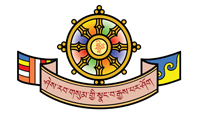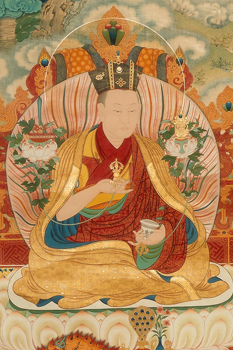38. 15th Karmapa 1871 - 1922
|
„Whoever hears your name is led to the path of liberation, Lord Khakyab Dorje, I supplicate you.” -- “Supplication to the Kagyü Gurus”
The Fifteenth Gyalwa Karmapa, Kungzang Khakyab Dorje, was born with the very auspicious circle of hair between his eyebrows, which is one of the 32 marks of an enlightened being and was found on young Prince Siddhartha who became Buddha Sakyamuni. Khakyab Dorje spoke the mantra of ‘Phagpa Chenrezig when he was born in the village called Shelkor that is situated in the Tsang Province of Central Tibet. The Buddhist Resource Center recounts that the name of the village where he was born was Gyeltsetul. His father’s name was Nyendrag Wangpo, and his mother’s name was Kelzang Dolma. He was recognized and, when he was 4 years old, enthroned with the Black Vajra Crown of the Gyalwa Kamarpas at Tsurphu Gon in the Tölung Valley, the main seat of the Karmapas in Tibet.
Khakyab Dorje grew up receiving the best education from the foremost scholars in Tibet. His Root Guru, Jamgon Kongtrul Lodrö Thaye the Great, passed on to him the sacred oral empowerments and the essence of his more than ninety compositions that consist of the general and profound instructions of all Tibetan Buddhist traditions, as well as the fields of medicine, art, and linguistics. Khakyab Dorje studied with many other great masters, such as Jamyang Khyentse Wangpo (who, as we saw in the last essay, was one of the most complete spiritual masters of the 19 th century and was Jamgon Kongtrul Lodrö Thaye’s teacher, inspiration, and friend), Kyabgon Drugchen, Mingyur Wangi Gyalpo, Pawo Tsuglag Nyinchey, and Tashi Özer.
Khakyab Dorje is the first in the line of Karmapas who married and had children. One of his sons was recognized as the Second Jamgon Kongtrul Rinpoche, Pälden Khyentse Öser. His second son’s name was Jamyang Rinpoche (the Twelfth Shamar). His wife’s name was Daki Wangpo. Kungzang Khakyab Dorje unfailingly continued carrying out the activities of the Gyalwa Karmapas by teaching and giving empowerments throughout Tibet and he preserved many rare texts by having them printed. His own writings make up ten volumes. Next to his sons, the names of the Fifteenth Karmapa’s main students were Pema Wangchug Gyalpo (the Eleventh Tai Situpa), Tsuglag Nangwa Wangchug (the Tenth Pawo Rinpoche), Chökyi Gyatso, Dragpa Gyatso, and Jampäl Tsultrim. Having been urged by Karma Gyalwang, he wrote a song in which he supplicated his Root Guru, Jamgon Kongtrul Lodrö Thaye, while offering profound and practical instructions. He called it “A Canopy of Fresh Sky Flowers.” It is entitled “The Songs of Khakhyap Dorje” in “The Rain of Wisdom.” A few verses following the introduction that readers will find in the previous life-story: “NAMO GURU-GUNASAGARAYA You are the primordial ground, Buddha Vajradhara, Unobstructed manifestation, the body of great compassion. You possess the kindness that delivers Buddha into the palm of one’s hand, Please enjoy being an ornament on the top of my head.
“Having obtained a human body this one time, I was accepted by your great kindness, lord. You, the jetsün who makes this free and well-favored birth meaningful, Please dwell inseparably in the very center of my heart.
“Your son supplicates with devotion and longing; Father rinpoche, please look on me with kindness. Lord, by the light rays of your kindness, The darkness of confused ego-fixation has been cleared. (…)
“In this lowest of the low times, when the five corruptions are rampant: Life is brief like a flash of lightning in the sky. Wealth is impermanent like dew on the grass. A friend who loves you in the morning hates you by the evening. All these are like last night’s dream. In general, everything is impermanent, moving and changing. Now, cast away all desires of fixation on permanence. Father guru, please think of me and look upon me with kindness. (…)
“One should take on the suffering of all the mothers in the six realms. This is the wisdom-flame of oral instructions that cleanses obscurations. (…) And cast away unnecessary activities. Father, please know me; knower of the three times, know me. Trusting that you know best whatever you do, With a song of longing through the six periods of day and night, Your son supplicates with one-pointed longing, Father, please look on me with kindness and grant your blessings.
“Unfabricated devotion blazes. Please raise the wisdom of the simultaneity of liberation and realization. May auspicious coincidence come together for the spontaneous benefit of all beings. Lord, please make me inseparable from you.”
Having unwavering Guru devotion and compassion for all living beings, the life of the Fifteenth Gyalwa Karmapa was a perfect example of a Bodhisattva who had an insatiable interest to learn in order to help everyone. Before passing into Parinirvana at the age of 51, he entrusted a prediction letter to his closest attendant.
Prophecies
“The world has given us much, an Staff in which we live and practice. Now we should consider how to give back.” -- His Holiness the Seventeenth Gyalwa Karmapa, Ogyen Trinley Dorje
As we saw in the last essay, Terton Chogyur Lingpa lived during the lifetime of the Fourteenth Karmapa. In a prophecy, he foretold the names of the Fifteenth, Sixteenth, and Seventeenth Karmapas and the events surrounding their lives, up to the Twenty-first Karmapa. He spoke the following prophecy about the Fifteenth, Sixteenth, and Seventeenth Gyalwa Karmapas:
“On the left, in a rock cave in a snow mountain, is the Fifteenth Karmapa, together with his attendant and disciples, exerting themselves in sacred tantric yoga practices. By the virtue of his realization, born through practicing the Six Yogas of Naropa, his activity will extend throughout the Land of Snows. On the right, in a sacred temple with a golden pinnacle and turquoise pagoda roof, the Sixteenth Karmapa discusses the Dharma with his tutor. On the upper floor is the Lord Buddha Shakyamuni. These images signify that he will attain universal renown as the indisputable lord of the doctrine of the sutras and tantras. Nearby, at the foot of a lush tree on a rock mountain, is the Seventeenth incarnation together with Khentin Tai Situpa. This image symbolizes that, through the unity of their minds, the tree of the Buddha's doctrine will flourish, laden with the ripe fruit which is the essence of the teachings of the lineage of Gampopa.”
During the Great Kagyü Mönlam in Bodhgaya in 2007, His Holiness the Seventeenth Gyalwa Karmapa spoke about the Tenth Pawo Rinpoche, Mawey Wangchug (who lived during the late part of the life of the Fifteenth Karmapa and the entire lifetime of the Sixteenth Karmapa) and tells us: “The Lord Buddha and many of the earlier learned and realized masters who followed him made prophecies a long time ago about how the times would become degenerate: the Staff would degenerate, and beings living in it would also degenerate. These are things the earlier masters said (…).”
His Holiness continued: “I want to tell you a story. During the upheavals in Tibet in the 1950s, the previous incarnation of Pawo Rinpoche was looking through the prophecies of Guru Rinpoche and thought, ‘This probably is going to happen.’ He showed them to his steward and said, ‘This is going to happen. These are the prophecies of Guru Rinpoche. We need to flee into exile; we cannot stay here.’ Whenever he showed these to his steward, the steward would say, ‘So it is! I go for refuge!’ The steward would then touch them to his forehead and put them aside. Later the situation got worse, and even the Karmapa went to India. When Pawo Rinpoche heard about that, he said, ‘The prophecies predicted this! Even the Karmapa has gone. We had better go, or what will happen to us?’ The steward replied, ‘How can that be? There are the three great monasteries of Sera, Drepung, and Ganden, and the Tibetan government palace of the Potala. It is not easy to leave. If you prepare to go, you will ruin any chance of staying.’ He absolutely refused to do anything about leaving. Either he was not educated or he was complacent because he had never faced such difficult circumstances. In the end, the steward was unable to come to India and suffered terribly. (…) It is similar with us. The Lord Buddha and earlier masters said a great deal about how we need to protect the Staff, the forests, and the trees. But when we hear this, we just touch the text to our foreheads and say, ‘I go for refuge!’ The eloquent and beautiful words, ‘May it be so! May there be benefit for all! May it happen! May this be for all sentient beings throughout space! May that be!’ often pass our lips, but we do not practice them in a meaningful way. We are still wandering in the oceans of samsaric suffering because our wishes and our actions are going in opposite directions. If we continue in this way, we will remain in samsara forever. There’s no other benefit. So please keep this in mind.”
His Holiness the Fourteenth Dalai Lama: “Actually, we Buddhists are supposed to save all sentient beings, but practically speaking, this may be too broad a notion for most people. In any case, we must at least think in terms of helping all human beings. This is very important. Even if we cannot think in terms of sentient beings inhabiting different worlds, we should nonetheless think in terms of the human beings on our own planet. To do this is to take a practical approach (…). It is necessary to help others, not only in our prayers, but in our daily lives. If we find we cannot help another, the least we can do is to desist from harming them. We must not cheat others or lie to them. We must be honest human beings, sincere human beings. On a very practical level, such attitudes are things which we need. Whether one is a believer, a religious person, or not, is another matter. Simply as an inhabitant of the world, as a member of the human family, we need this kind of attitude. It is through such an attitude that real and lasting world peace and harmony can be achieved. Through harmony, friendship, and respecting one another, we can solve many problems in the right way, without difficulties.”
References: Kagyu Office of His Holiness the 17th Gyalwang Karmapa, Ogyen Trinley Dorje, “The Golden Rosary,” “Kagyu Lineage histories” (2008). The Seventeenth Gyalwa Karmapa, Ogyen Trinley Dorje, “Gyalwang Karmapa’s Advice on Protecting the Staff” & “More Words on the Staff,” in: Kagyu Monlam Chenmo, “Teachings” (2008). H.H. Dalai Lama, “Answers: Discussions with Western Buddhists,” N.Y., 2005. “The Rain of Wisdom. The Vajra Songs of the Kagyü Gurus,” transl. under the direction of Chögyam Trungpa by the Nalanda Translation Com., Boston & London, 1980, pages 102-111. The Himalaya Voice 97, “The Prophecy of Guru,” reprinted in: Karma Kagyü Association, Langenfeld (2008). Tibetan Buddhist Resource Center , “Biographical Data: The Karmapas,” N.Y. (2008).
May we take the teachings to heart and practice as best as we possibly can!
(A huge “thank you” to Khenpo Karma Namgyal for benefiting others so much, compiled and written by Gaby Hollmann, solely responsible for mistakes, Munich, Sept. 2008.) |


